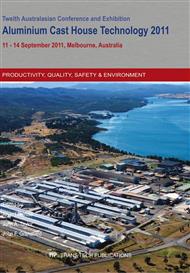p.13
p.24
p.33
p.44
p.54
p.63
p.73
p.80
p.90
SPH Modeling of the Effect of Crucible Tipping Rate on Oxide Formation
Abstract:
When hot molten aluminium is poured into a furnace from crucibles, oxide is generated due to the interaction of the liquid metal with the surrounding air. The amount of oxide produced is a function of several factors including the rate at which the crucible is tilted, the height of the crucible in relation to the furnace position and the location of the pivot of rotation. In this paper we evaluate the effect of crucible tilting rate on oxide formation for an industrial scale crucible and furnace setup. The mesh free Smoothed Particle Hydrodynamics (SPH) method is used for modelling the metal flow and oxide prediction. The model predicts rapid oxidation rates during periods of energetic fluid motion on freshly exposed metal surface and lower oxidation rates as oxide thickness increases. Four crucible rotation rates typical of normal operating conditions in a smelter are evaluated. The simulations showed that oxide generated due to fresh free surface created from a falling stream makes only a limited contribution to the overall oxide generated for the time scales of interest in this study. The secondary flows observed in the furnace make a significant contribution to the overall oxide generated. The rate of oxidation decreases and eventually ceases at a sufficiently long time when there is no disruption to the protective oxide skin. There is a 75% increase in oxide generated for the highest tilt rate (crucible emptied in 40 s) compared with the lowest tilt rate (emptied in 2.0 min).
Info:
Periodical:
Pages:
54-62
Citation:
Online since:
July 2011
Authors:
Price:
Сopyright:
© 2011 Trans Tech Publications Ltd. All Rights Reserved
Share:
Citation:


